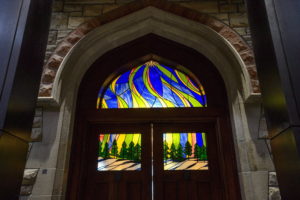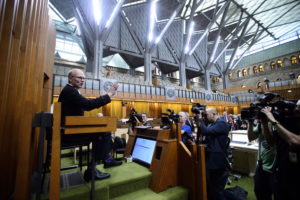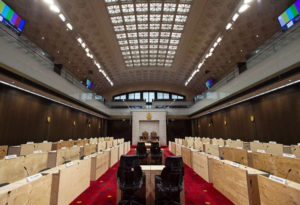
For at least the next decade, members of Parliament will meet in the West Block chamber while extensive renovations of Centre Block take place. The move might be temporary, but the impact of working in this different space might have lasting effects on parliamentary culture. Though the new House is unmistakably a parliamentary chamber, it is a spatial, cultural and aesthetic departure from its former home. The West Block chamber represents a new chapter in the history of Canadian governance, altering how the House of Commons interacts with those who occupy and orbit it, parliamentarians and public alike.
In a legislature, even aesthetic elements carry important weight. Centre Block architect John A. Pearson envisioned a design that bears a heavy symbolic burden, with allegories physically built into the building — the central pillar of the rotunda, for example, anchors a recurring “ship of state” metaphor, with Poseidon carved at its base. Pearson’s intellectual successor, Dominion Sculptor R. Eleanor Milne, filled the Centre Block chamber with symbolic sculpture and designed the striking stained glass windows ringing the Commons with representations of the various regions of the country.
While Centre Block is frothing with ornamentation, West Block features clean lines and flat planes, stripped of all overt representation of people or place. The building does have an Arctic-themed stained glass piece set in the northern doors; however, the only decorative features within the chamber itself and visible to visitors are six abstract bronze medallions. Political theorist John Parkinson has written of iconography in legislatures that resonates with citizens and strengthens their sense of inclusion in democracy. Its absence may, therefore, undermine that sense of inclusion: Canadians may feel distant from a House of Commons that offers little obvious representation of the people or the country that it serves.

While symbolism was not a major consideration for the design of West Block, acoustics was fundamental. The enhanced acoustic design could have a significant impact on parliamentary culture. Any visitor to Centre Block could speak of its terrible acoustics, speech from the chamber floor being nearly indiscernible without the use of earphones. It is little better for MPs themselves: according to Charles Robert, Clerk of the House, debate suffers because members cannot hear each other properly.
In contrast, the West Block chamber was designed so that a voice from the floor could be understood clearly by all members, and even at the back of the visitors’ galleries. The enhanced resonance of each voice could further encourage heckling. Alternatively, this disruptive capacity may encourage the Speaker to vigorously tamp down on interruptions, fostering a quieter and more attentive audience. In the first few months of use, House officials have found that the Speaker has needed to intervene in debates more frequently. However, it is unclear whether this has more to do with the acoustic properties of the chamber or with the especially dramatic political developments of the last months.
Furthermore, MPs’ behaviour could be affected if Hansard staffers, the press or the visiting public can clearly hear comments and heckles. If so, the acoustics of the West Block chamber may shift the tenor of debate, as the enhanced risk of exposure for the sources of particularly derogatory comments would discourage disrespect.
House of Commons officials have also found that noise from the scrum area in the antechamber of the House, as well as from conversations between MPs and staff in the outer courtyard surrounding the chamber, contributes to the overall background noise in the chamber. House architects have not yet decided whether behavioural or engineering adjustments are required to mitigate the noise, but it is clear that the acoustic resonance of the space has been vastly improved over Centre Block’s chamber.

Another significant change in West Block is the openness of its design. While Centre Block, Charles Robert concedes, felt confined and isolated, the new chamber gives an immediate impression of light and space. This larger chamber has no full walls bounding it; galleries rise up around the sitting area but do not reach the glass skylight that soars several storeys above. Beyond the galleries, the windows of offices ringing the courtyard are visible from the floor. These offices, according to senior Public Services and Procurement Canada officials, create a “surround of activity,” while the skylight allows members to see outside of the chamber and lets natural light into the space. The new chamber, while lacking in symbolic representation, gives the impression of being embedded in the world beyond it, rather than in a world of its own, making the public present in the chamber in a way it has not been before.

The windows surrounding the space introduce a unique dynamic to the relationship between the public and the sitting chamber by enhancing the presence of the public gaze. Parliamentary staff, who are ultimately members of the public, occupy the offices behind the windows. These windows, though frosted, give the impression of constant potential observation. This could have very different effects: when the public gaze is obvious, such as during question period, there is a sharpening of partisan discourse and a heightening of tension. It is possible that this spirit will become prevalent throughout the day if MPs internalize a sense of constant observation. However, it could also have the reverse effect: the visible activity of the public in the offices surrounding MPs may remind them of their role to serve that public, encouraging disciplined conduct.
Public access to and interaction with the chamber will also change. There will be no tours of West Block while the House sits, and public spaces around Centre Block, such as the lawns, will be lost to construction. The gallery of West Block is much smaller, with 340 seats to Centre Block’s 581. It is therefore possible that these smaller galleries, which are positioned to face members, will be more frequently occupied outside of question period. A more visible public not only would change the character of routine proceedings, but may also affect MPs’ behaviour through either enhanced tension or greater attention to conduct. According to Parkinson, enhanced presence of the public could lead to a more disciplined, active and engaged style of debate.
The West Block move will affect members’ interactions not only with each other and with the public, but with their Senate colleagues as well. The two chambers now sit about 600 metres apart, which will likely affect how many MPs respond to the Usher of the Black Rod’s traditional summons to Throne Speech or royal assent ceremonies. Furthermore, it is unclear whether there is a plan for how to shuttle members between buildings. , One wonders whether these traditions will persist, adapt or gradually vanish after 10 years of living with this logistical hurdle have elapsed.

Another challenge to procedure involves the tradition of running amendments to bills between chambers; according to Robert, these must be delivered on paper. During certain seasons of the parliamentary cycle, amendments can be particularly time-sensitive. Distance introduces even greater urgency to this delivery, with the logistical difficulty of traversing 600 metres of pedestrian or traffic congestion potentially resulting in procedural, or even legislative, issues.
The physical separation of the chambers will surely affect the dynamic between their respective members. The new Parliamentary Dining Room, one of the primary communal spaces for MPs and senators, is smaller and located in West Block; therefore, it is unlikely that senators will choose to eat there. With a Senate that is increasingly asserting itself through legislative challenges to the House, distance between the chambers could exacerbate the tension between them as MPs and senators interact less frequently, and progressively become abstractions to each other rather than individuals.
Parliament is about to face the most significant disruption in its history, and while its traditions are old, they are far from static. After 10 years, it is unlikely that every cultural and institutional tradition will remain intact, yet the effects of the new chamber will likely be gradual and difficult to detect. If we are to believe philosopher Martin Heidegger’s architectural theories, buildings respond to those who dwell within them, and West Block will adapt progressively to the needs of both parliamentarians and the public. Over the next decade, as we witness this dance between form and function, tradition and progression, and past and future, let us remember that we are witnessing but another chapter in the ever-evolving story of Canadian democracy.
Photo: Members of Parliament gather for a group photo in the temporary House of Commons in the West Block of Parliament Hill in Ottawa on Jan. 30, 2019. THE CANADIAN PRESS/Sean Kilpatrick
Do you have something to say about the article you just read? Be part of the Policy Options discussion, and send in your own submission. Here is a link on how to do it. | Souhaitez-vous réagir à cet article ? Joignez-vous aux débats d’Options politiques et soumettez-nous votre texte en suivant ces directives.







